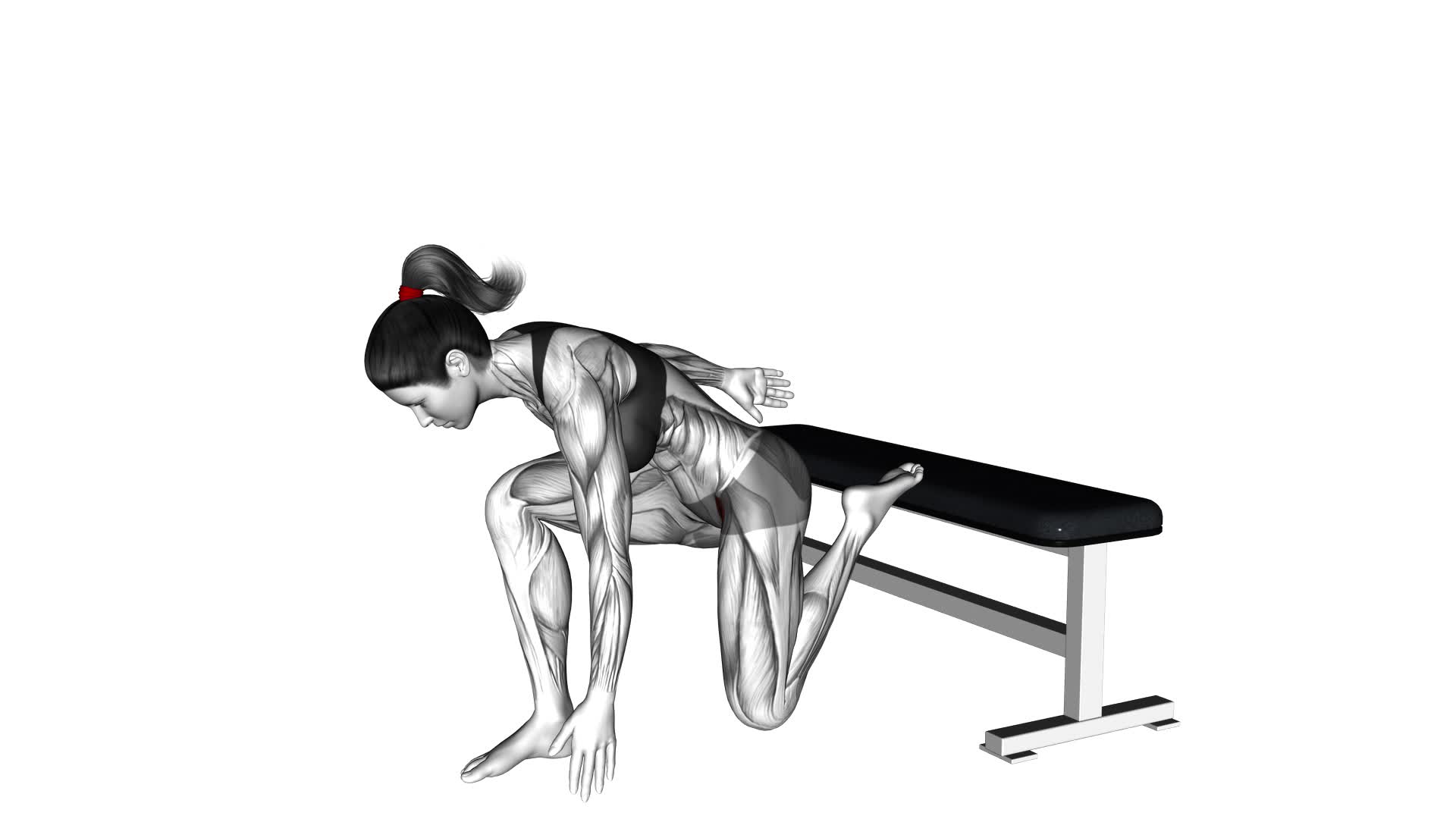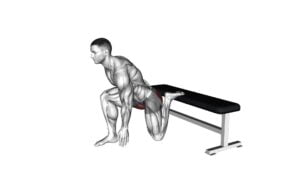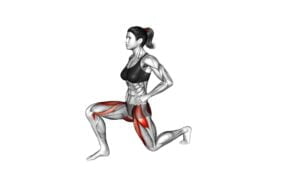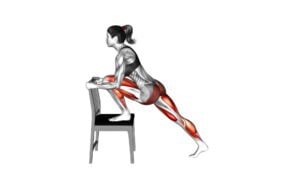Hip Flexor Stretch Rear Foot Elevated (Female) – Video Exercise Guide & Tips

Get ready to stretch and strengthen your hip flexors with this easy-to-follow video exercise guide.
Watch This Exercise Video
In just a few minutes a day, you'll learn how to properly perform the hip flexor stretch with your rear foot elevated.
By incorporating this exercise into your routine, you'll experience increased flexibility, improved posture, and reduced lower back pain.
So grab a mat and get ready to feel the burn – your hip flexors will thank you!
Key Takeaways
- The hip flexor stretch improves flexibility and reduces tightness in the hip flexor muscles.
- This stretch enhances athletic performance, increases power generation, and agility.
- It is important to maintain proper form, engage core muscles, and avoid common mistakes like arching the lower back.
- Increasing intensity and variation can be achieved by adding resistance, incorporating alternative stretches, and gradually challenging the muscles.
Benefits of the Hip Flexor Stretch
By performing the hip flexor stretch, you can effectively improve your flexibility and reduce tightness in your hip flexor muscles. Hip flexibility is important for a variety of reasons, especially when it comes to athletic performance. When your hip flexors are tight, it can limit your range of motion and hinder your ability to perform certain movements. This can be particularly problematic for athletes who rely on explosive movements or quick changes in direction.
Stretching your hip flexors regularly can help to improve your overall athletic performance. By increasing your flexibility in this area, you can enhance your ability to generate power and improve your agility. This can be especially beneficial for sports like running, jumping, and kicking, where strong hip flexors are crucial.
Additionally, having flexible hip flexors can help to prevent injuries. When your muscles are tight, they're more susceptible to strains and tears. By incorporating the hip flexor stretch into your routine, you can reduce the risk of these types of injuries and keep yourself performing at your best.
Proper Setup and Equipment Needed
To properly set up for the hip flexor stretch, you'll need a raised surface such as a step or bench. Here are the steps to ensure proper alignment and modifications for beginners:
- Find a stable raised surface: Look for a step or bench that's sturdy and secure. This will provide the necessary support for your body during the stretch.
- Position your body: Stand facing away from the raised surface with one foot placed on top of it. Your front foot should be flat on the ground, with your knee bent at a 90-degree angle.
- Maintain proper alignment: Keep your torso upright and engage your core muscles to stabilize your body. Make sure your hips are squared and facing forward.
For beginners, you can modify the stretch by using a lower surface or placing your back knee on a soft mat for added support. This will help you ease into the stretch and prevent any unnecessary strain.
Now that you know how to set up properly, let's move on to the step-by-step guide for the hip flexor stretch.
Step-by-Step Guide for the Exercise
To begin the hip flexor stretch, position your body with one foot on a raised surface and your front foot flat on the ground. Make sure the raised surface is sturdy and secure. Place your hands on your hips for stability.
Now, gently shift your weight forward, bending your front knee slightly. You should feel a stretch in the hip of the back leg. Hold this position for 20 to 30 seconds, focusing on breathing deeply and relaxing into the stretch.
If you want to intensify the stretch, you can raise your arms above your head or lean slightly forward. Remember to keep your back straight and avoid arching or rounding your spine.
If you experience any pain or discomfort, adjust your position or stop the exercise.
To modify this exercise, you can use a lower surface or perform the stretch while kneeling on the ground. Alternative exercises that target the hip flexors include lunges, standing leg lifts, or using a resistance band for added resistance.
Remember to consult with a healthcare professional before starting any new exercise routine, especially if you have any pre-existing conditions or injuries.
Common Mistakes to Avoid
When performing the hip flexor stretch with the rear foot elevated, it's important to be aware of common mistakes to avoid. Maintaining proper form is crucial to ensure you get the most benefit from this exercise and prevent any potential injuries.
Here are three common mistakes to watch out for:
- Arching your lower back: Avoid leaning too far forward or arching your lower back during the stretch. This can place unnecessary strain on your lower back and take away from the effectiveness of the stretch. Instead, engage your core muscles and keep your spine neutral.
- Overstretching: While it's important to feel a stretch in your hip flexors, avoid pushing yourself too far. Gradually increase the intensity of the stretch over time, but never to the point of pain or discomfort. Listen to your body and adjust accordingly.
- Neglecting alternative stretches: The hip flexor stretch with the rear foot elevated is just one of many effective stretches for this muscle group. It's important to vary your routine and incorporate other stretches that target the hip flexors from different angles. Some alternative stretches include the kneeling hip flexor stretch and the standing lunge stretch.
Tips for Increasing Intensity and Variation
To increase the intensity and variation of the hip flexor stretch with the rear foot elevated, try incorporating these tips into your routine.
- Increase the duration of the stretch. Instead of holding it for 30 seconds, try holding it for 45 seconds or even a minute. This will help to further stretch and lengthen your hip flexors, increasing flexibility over time.
- Add resistance to the stretch. You can do this by using a resistance band or holding onto a weight while performing the stretch. The added resistance will challenge your muscles and make the stretch more effective.
- Incorporate alternative stretches into your routine. This will help to target different areas of the hip flexors and provide a well-rounded stretch. Some alternative stretches you can try include lunges, pigeon pose, and butterfly stretch.
Frequently Asked Questions
How Long Should I Hold the Hip Flexor Stretch For?
To properly perform the hip flexor stretch, it's important to know how long to hold it for. The ideal duration is around 30 seconds to a minute. Holding the stretch for this amount of time allows your muscles to fully relax and lengthen.
It's also important to avoid common mistakes, such as arching your back or leaning too far forward. Maintaining proper form will ensure you get the most out of the stretch and prevent any potential injuries.
Can I Perform the Hip Flexor Stretch if I Have a History of Knee Injuries?
If you have a history of knee injuries, it's important to consider how the hip flexor stretch might affect your knees. Can the hip flexor stretch worsen knee injuries? Is there a specific technique for performing the stretch safely?
While I can't provide specific advice without the context of the exercise, it's always a good idea to consult with a healthcare professional or a qualified trainer who can assess your individual situation and provide guidance on modifying exercises to accommodate your knee issues.
Is It Normal to Feel Discomfort or Tightness in the Hip Flexors During the Stretch?
Feeling discomfort or tightness in your hip flexors during the stretch is normal.
To alleviate these sensations, focus on breathing deeply and relaxing your muscles.
You can also try adjusting the height of the elevation or the angle of your body to find a more comfortable position.
Avoid overstretching or rushing through the exercise, as this can lead to further discomfort.
Remember to listen to your body and modify the stretch as needed for maximum effectiveness.
Can the Hip Flexor Stretch Help Improve My Posture?
Improving your posture is one of the benefits of the hip flexor stretch. By stretching your hip flexors, you can help release tension in the muscles and improve their flexibility.
This can lead to better alignment of your spine and pelvis, which in turn can improve your overall posture.
Are There Any Modifications or Alternatives for Individuals Who Have Limited Flexibility or Mobility?
If you have limited flexibility or mobility, there are modifications and alternatives you can try for the hip flexor stretch.
You can use a support like a yoga block or a cushion under your knee to reduce the intensity.
Another option is to perform the stretch in a seated position instead of standing.
As you progress, you can gradually increase the range of motion and hold the stretch for longer periods of time to improve flexibility and mobility.
Conclusion
In conclusion, the hip flexor stretch with the rear foot elevated is a beneficial exercise for improving flexibility and mobility in the hip area.
By following the proper setup and using the right equipment, you can effectively target and stretch the hip flexor muscles.
Avoiding common mistakes and incorporating tips to increase intensity and variation will help you maximize the benefits of this exercise.

Author
Years ago, the spark of my life’s passion ignited in my mind the moment I stepped into the local gym for the first time. The inaugural bead of perspiration, the initial endeavor, the very first surge of endorphins, and a sense of pride that washed over me post-workout marked the beginning of my deep-seated interest in strength sports, fitness, and sports nutrition. This very curiosity blossomed rapidly into a profound fascination, propelling me to earn a Master’s degree in Physical Education from the Academy of Physical Education in Krakow, followed by a Sports Manager diploma from the Jagiellonian University. My journey of growth led me to gain more specialized qualifications, such as being a certified personal trainer with a focus on sports dietetics, a lifeguard, and an instructor for wellness and corrective gymnastics. Theoretical knowledge paired seamlessly with practical experience, reinforcing my belief that the transformation of individuals under my guidance was also a reflection of my personal growth. This belief holds true even today. Each day, I strive to push the boundaries and explore new realms. These realms gently elevate me to greater heights. The unique combination of passion for my field and the continuous quest for growth fuels my drive to break new ground.







